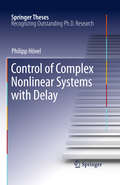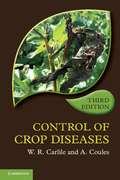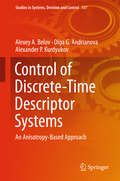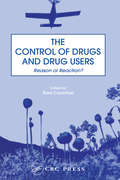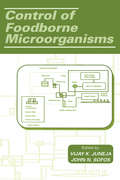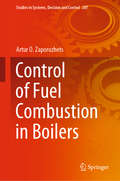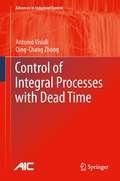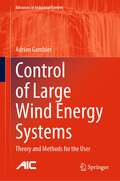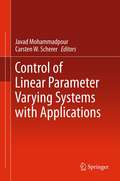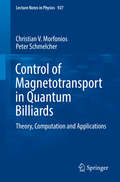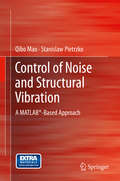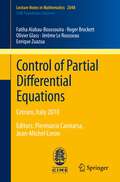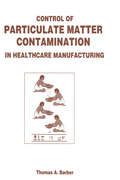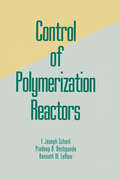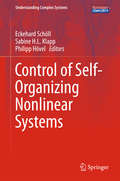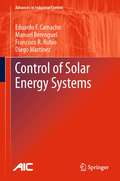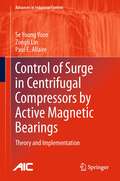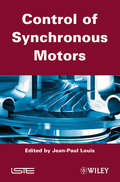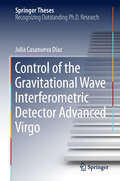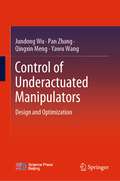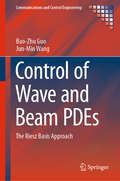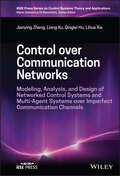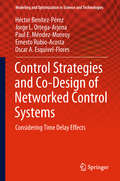- Table View
- List View
Control of Complex Nonlinear Systems with Delay (Springer Theses)
by Philipp HövelThis research addresses delay effects in nonlinear systems, which are ubiquitous in various fields of physics, chemistry, biology, engineering, and even in social and economic systems. They may arise as a result of processing times or due to the finite propagation speed of information between the constituents of a complex system. Time delay has two complementary, counterintuitive and almost contradictory facets. On the one hand, delay is able to induce instabilities, bifurcations of periodic and more complicated orbits, multi-stability and chaotic motion. On the other hand, it can suppress instabilities, stabilize unstable stationary or periodic states and may control complex chaotic dynamics. This thesis deals with both aspects, and presents novel fundamental results on the controllability of nonlinear dynamics by time-delayed feedback, as well as applications to lasers, hybrid-mechanical systems, and coupled neural systems.
Control of Crop Diseases
by W. R. Carlile A. CoulesThoroughly revised and updated to reflect current and emerging practices, this book explores modern methods of disease control in field and glasshouse crops. It outlines the major crop diseases, with a particular emphasis on those features of symptomology and life cycle that are most relevant to the development of control measures. Modern diagnostic techniques are considered, focusing on developments in nucleic acid and immunological based procedures and their use in plant quarantine and certification schemes. The potential impact of these advances in molecular technology on plant breeding and disease resistance is also covered. Fungicides are a central part of disease control in the EU and, as such, a comprehensive account of their use forms an important part of the text, along with strategies to minimise the incidence of fungicide resistance in pathogen populations. Looking to the future, the book also addresses legislative, environmental and food safety concerns.
Control of Discrete-Time Descriptor Systems: An Anisotropy-based Approach (Studies In Systems, Decision And Control #157)
by Alexey A. Belov Olga G. Andrianova Alexander P. KurdyukovControl of Discrete-Time Descriptor Systems takes an anisotropy-based approach to the explanation of random input disturbance with an information-theoretic representation. It describes the random input signal more precisely, and the anisotropic norm minimization included in the book enables readers to tune their controllers better through the mathematical methods provided. The book contains numerous examples of practical applications of descriptor systems in various fields, from robotics to economics, and presents an information-theoretic approach to the mathematical description of coloured noise. Anisotropy-based analysis and design for descriptor systems is supplied along with proofs of basic statements, which help readers to understand the algorithms proposed, and to undertake their own numerical simulations. This book serves as a source of ideas for academic researchers and postgraduate students working in the control of discrete-time systems. The control design procedures outlined are numerically effective and easily implementable in MATLAB®
The Control of Drugs and Drug Users: Reason or Reaction?
by Ross CoomberInformed debate on how, why, or even if, drugs and those that use them should be controlled needs an insight into the background of such controls, how effective they have been and what reasonable alternatives there may be. This book seeks to provide such an insight. Reviewing important aspects of past and current drug control policies in Britain and America, the international compliment of expert contributors seek to explore the rationality of the reasoning which produced the initial controls, the continuing relevance of those currently employed, and provide alternative scenarios for future policy.
Control of Foodborne Microorganisms
by Vijay K. Juneja John N. SofosPresents the latest research in the control of foodborne pathogens. Emphasizes traditional and emerging techniques as well as current applications for the inactivation of microorganisms to reduce illness and enhance food safety and quality.
Control of Fuel Combustion in Boilers (Studies in Systems, Decision and Control #287)
by Artur O. ZaporozhetsThis book examines key issues in improving the efficiency of small and medium power boiler units by adding control systems for the fuel combustion process. The original models, algorithms, software and hardware of the system developed for controlling the fuel combustion process are presented. In turn, the book presents a methodology for assessing the influence of climatic factors on the combustion process, and proposes new methods for measuring the thermophysical characteristics, which require taking into account the concentration of oxygen in the air. The system developed here was implemented on a boiler of the NIISTU-5 type, which is widely used for heat power engineering in Ukraine and other Eastern European countries. Given its scope, the book offers a valuable asset for researchers and engineers, as well as lecturers and graduate students at higher education institutions dealing with heat engineering equipment.
Control of Innate and Adaptive Immune Responses during Infectious Diseases
by Julio AlibertiUpon infection the host needs to mount vigorous immune response against pathogen in order to successfully control its replication. However, once the infectious agent is controlled or eliminated, host cells need to signal the immune system to slow or cease its activities. While vast knowledge has been accumulated through the years on the mechanisms involved in the initiation and effector phases of the immune responses, the pathways triggered in order to modulate or end innate and acquired immunity are becoming more evident as evidence for its relevance comes to surface. Due to its biological power, evidence has surfaced indicating that eventually pathogens may take advantage of such regulatory pathways in order to escape effector mechanisms and progress to persistence. This book will discuss several cellular pathways involved in controlling immune response in the context of infectious diseases, their biological consequences and potential "hijack" of these pathways for the benefit of pathogen leading towards pathogen persistence as opposed to clearance.
Control of Integral Processes with Dead Time (Advances in Industrial Control)
by Antonio Visioli Qingchang ZhongControl of Integral Processes with Dead Time provides a unified and coherent review of the various approaches devised for the control of integral processes, addressing the problem from different standpoints. In particular, the book treats the following topics: How to tune a PID controller and assess its performance; How to design a two-degree-of-freedom control scheme in order to deal with both the set-point following and load disturbance rejection tasks; How to modify the basic Smith predictor control scheme in order to cope with the presence of an integrator in the process; and how to address the presence of large process dead times. The methods are presented sequentially, highlighting the evolution of their rationale and implementation and thus clearly characterising them from both academic and industrial perspectives.
Control of Large Wind Energy Systems: Theory and Methods for the User (Advances in Industrial Control)
by Adrian GambierWind energy systems are central contributors to renewable energy generation, and their technology is continuously improved and updated. Without losing sight of theory, Control of Large Wind Energy Systems demonstrates how to implement concrete control systems for modern wind turbines, explaining the reasons behind choices and decisions. This book provides an extended treatment of different control topics divided into three thematic parts including modelling, control and implementation. Solutions for real-life difficulties such as multi-parameter tuning of several controllers, curve fitting of nonlinear power curves, and filter design for concrete signals are also undertaken. Examples and a case study are included to illustrate the parametrization of models, the control systems design with problems and possible solutions. Advice for the selection of control laws, calculation of specific parameters, which are necessary for the control laws, as the sensitivity functions, is given, as well as an evaluation of control performance based on indices and load calculation. Control of Large Wind Energy Systems covers methodologies which are not usually found in literature on this topic, including fractional order PID and nonlinear PID for pitch control, peak shaving control and extremum seeking control for the generator control, yaw control and shutdown control. This makes it an ideal book for postgraduate students, researchers and industrial engineers in the field of wind turbine control. Advances in Industrial Control reports and encourages the transfer of technology in control engineering. The rapid development of control technology has an impact on all areas of the control discipline. The series offers an opportunity for researchers to present an extended exposition of new work in all aspects of industrial control.
Control of Linear Parameter Varying Systems with Applications
by Carsten W. Scherer Javad MohammadpourControl of Linear Parameter Varying Systems compiles state-of-the-art contributions on novel analytical and computational methods for addressing system identification, model reduction, performance analysis and feedback control design and addresses address theoretical developments, novel computational approaches and illustrative applications to various fields. Part I discusses modeling and system identification of linear parameter varying systems, Part II covers the importance of analysis and control design when working with linear parameter varying systems (LPVS) , Finally, Part III presents an applications based approach to linear parameter varying systems, including modeling of a turbocharged diesel engines, Multivariable control of wind turbines, modeling and control of aircraft engines, control of an autonomous underwater vehicles and analysis and synthesis of re-entry vehicles.
Control of Magnetotransport in Quantum Billiards: Theory, Computation and Applications (Lecture Notes in Physics #927)
by Christian V. Morfonios Peter SchmelcherIn this book the coherent quantum transport of electrons through two-dimensional mesoscopic structures is explored in dependence of the interplay between the confining geometry and the impact of applied magnetic fields, aiming at conductance controllability. After a top-down, insightful presentation of the elements of mesoscopic devices and transport theory, a computational technique which treats multiterminal structures of arbitrary geometry and topology is developed. The method relies on the modular assembly of the electronic propagators of subsystems which are inter- or intra-connected providing large flexibility in system setups combined with high computational efficiency. Conductance control is first demonstrated for elongated quantum billiards and arrays thereof where a weak magnetic field tunes the current by phase modulation of interfering lead-coupled states geometrically separated from confined states. Soft-wall potentials are then employed for efficient and robust conductance switching by isolating energy persistent, collimated or magnetically deflected electron paths from Fano resonances. In a multiterminal configuration, the guiding and focusing property of curved boundary sections enables magnetically controlled directional transport with input electron waves flowing exclusively to selected outputs. Together with a comprehensive analysis of characteristic transport features and spatial distributions of scattering states, the results demonstrate the geometrically assisted design of magnetoconductance control elements in the linear response regime.
The Control Of Nature
by John McpheeThese three essays center around man's influence on nature and how it (nature) fights back. The First essay centers on New Orleans and how man's influence has contributed to it's now demise. Though written in 1989, Mcphee's research pretty much describes how Katrina, or in the case of the book, a theoretical storm, could have been made much less destructive had development been much less. The second article discusses efforts in Iceland to cool lava with saltwater and stop the destruction of a town. The third describes Los Angeles's expansion and possible demise due to run off and mud slides from the San Gabriel mountains. His premise in all three articles basically is, nature will ultimately have the last word in it's ultimate design.
Control of Noise and Structural Vibration: A MATLAB®-Based Approach
by Qibo Mao Stanislaw PietrzkoControl of Noise and Structural Vibration presents a MATLAB®-based approach to solving the problems of undesirable noise generation and transmission by structures and of undesirable vibration within structures in response to environmental or operational forces. The fundamentals of acoustics, vibration and coupling between vibrating structures and the sound fields they generate are introduced including a discussion of the finite element method for vibration analysis. Following this, the treatment of sound and vibration control begins, illustrated by example systems such as beams, plates and double walls. Sensor and actuator placement is explained as is the idea of modal sensor-actuators. The design of appropriate feedback systems includes consideration of basic stability criteria and robust active structural acoustic control. Positive position feedback (PPF) and multimode control are also described in the context of loudspeaker-duct and loudspeaker-microphone models. The design of various components is detailed including the analog circuit for PPF, adaptive (semi-active) Helmholtz resonators and shunt piezoelectric circuits for noise and vibration suppression. The text makes extensive use of MATLAB® examples and these can be simulated using files available for download from the book's webpage at springer.com. End-of-chapter exercises will help readers to assimilate the material as they progress through the book. Control of Noise and Structural Vibration will be of considerable interest to the student of vibration and noise control and also to academic researchers working in the field. It's tutorial features will help practitioners who wish to update their knowledge with self-study.
Control of Partial Differential Equations: Cetraro, Italy 2010, Editors: Piermarco Cannarsa, Jean-Michel Coron (Lecture Notes in Mathematics #2048)
by Enrique Zuazua Jérôme Le Rousseau Roger Brockett Olivier Glass Jean-Michel Coron Fatiha Alabau-Boussouira Piermarco CannarsaThe term "control theory" refers to the body of results - theoretical, numerical and algorithmic - which have been developed to influence the evolution of the state of a given system in order to meet a prescribed performance criterion. Systems of interest to control theory may be of very different natures. This monograph is concerned with models that can be described by partial differential equations of evolution. It contains five major contributions and is connected to the CIME Course on Control of Partial Differential Equations that took place in Cetraro (CS, Italy), July 19 - 23, 2010. Specifically, it covers the stabilization of evolution equations, control of the Liouville equation, control in fluid mechanics, control and numerics for the wave equation, and Carleman estimates for elliptic and parabolic equations with application to control. We are confident this work will provide an authoritative reference work for all scientists who are interested in this field, representing at the same time a friendly introduction to, and an updated account of, some of the most active trends in current research.
Control of Particulate Matter Contamination in Healthcare Manufacturing
by Thomas A. BarberWritten by an expert in the industry, this text addresses the specifics of contamination, including particle origination, characterization, identification, and elimination, with a special focus on quality. The author offers a clear and concise review of particle populations and their control in stability, efficacy, and predictability in the manufacture of healthcare products. He brings together information from over 100 Web sites and other sources and casts it into a practical framework that will help readers ensure their company's success. The book contains thirty-two color photomicrographs and over eighty figures, tables, and charts.
Control of Polymerization Reactors
by F. Joseph Schurk Pradeep B. Deshpande Kenneth W. Leffew Vikas M. NadkarniThis reference and text provides an in-depth description of developments in control techniques and their application to polymerization reactors and offers important introductory background information on polymerization reaction engineering.;Discussing modelling, identification, linear, nonlinear and multivariable schemes, Control of Polymerization Reactors: presents all available techniques that can be used to control reactors properly for optimal performance; shows how to manipulate pivotal variables that affect reactor control; examines methods for deriving dynamic process models to improve reactor efficiency; reviews reactor control problems and points out end-use properties; supplies methods for measuring process variables, and ways to estimate variables that can't be measured; and explains how single-input, single-output (SISO) strategies can be effectively used for control.;Filled with illustrative examples to clarify concepts, including more than 730 figures, tables and equations, Control of Polymerization Reactors is intended for use as a reference for chemical, process development, process design, research and development, control systems, and polymer engineers; and polymer chemists and physicists; as well as a text for upper-level undergraduate and graduate students in polymerization reactor control courses.
Control of Self-Organizing Nonlinear Systems (Understanding Complex Systems)
by Philipp Hövel Eckehard Schöll Sabine H. L. KlappThe book summarizes the state-of-the-art of research on control of self-organizing nonlinear systems with contributions from leading international experts in the field. The first focus concerns recent methodological developments including control of networks and of noisy and time-delayed systems. As a second focus, the book features emerging concepts of application including control of quantum systems, soft condensed matter, and biological systems. Special topics reflecting the active research in the field are the analysis and control of chimera states in classical networks and in quantum systems, the mathematical treatment of multiscale systems, the control of colloidal and quantum transport, the control of epidemics and of neural network dynamics.
Control of Solar Energy Systems (Advances in Industrial Control)
by Manuel Berenguel Diego Martínez Eduardo F. Camacho Francisco R. RubioControl of Solar Energy Systems details the main solar energy systems, problems involved with their control, and how control systems can help in increasing their efficiency. Thermal energy systems are explored in depth, as are photovoltaic generation and other solar energy applications such as solar furnaces and solar refrigeration systems. This second and updated edition of Advanced Control of Solar Plants includes new material on: solar towers and solar tracking; heliostat calibration, characterization and offset correction; solar radiation, estimation, prediction, and computation; and integrated control of solar plants. This new edition contains worked examples in the text as well as proposed exercises and simulation models and so will be of great use to the student and academic, as well as the industrial practitioner.
Control of Surge in Centrifugal Compressors by Active Magnetic Bearings: Theory and Implementation (Advances in Industrial Control)
by Paul E. Allaire Zongli Lin Se Young YoonSurge Control of Active-magnetic-bearing-suspended Centrifugal Compressors sets out the fundamentals of integrating active magnetic bearing (AMB) rotor suspension technology in compressor systems, and describes how this relatively new bearing technology can be employed in active control of compressor surge initiation. The authors provide a self-contained and comprehensive review of rotordynamics and the fundamentals of AMB technology. The active stabilization of compressor surge employing AMBs in a machine is fully explored, from modeling of instability and controller design, to the implementation and experimental testing of the control algorithm in a specially-constructed, industrial-size centrifugal compression system. The results of these tests demonstrate the great potential of the new surge control method suggested in this text. This book will be useful for engineers in industries that involve turbocompressors and magnetic bearings, as well as for researchers and graduate students in the field of applied control. Whatever their level of experience, engineers working in the fields of turbomachinery, magnetic bearings, rotordynamics and controls will find the material in this book absorbing as all these important aspects of engineering are integrated to create a multi-disciplinary solution to a real-life industrial problem and the book is a suitable introduction to the area for newcomers.
Control of Synchronous Motors (Wiley-iste Ser.)
by Jean-Paul LouisSynchronous motors are indubitably the most effective device to drive industrial production systems and robots with precision and rapidity. Their control law is thus critical for combining at the same time high productivity to reduced energy consummation. As far as possible, the control algorithms must exploit the properties of these actuators. Therefore, this work draws on well adapted models resulting from the Park’s transformation, for both the most traditional machines with sinusoidal field distribution and for machines with non-sinusoidal field distribution which are more and more used in industry. Both, conventional control strategies like vector control (either in the synchronous reference frame or in the rotor frame) and advanced control theories like direct control and predictive control are thoroughly presented. In this context, a significant place is reserved to sensorless control which is an important and critical issue in tomorrow’s motors.
Control of the Gravitational Wave Interferometric Detector Advanced Virgo (Springer Theses)
by Julia Casanueva DiazThis book focuses on the development and implementation of the longitudinal, angular and frequency controls of the Advanced Virgo detector, both from the simulation and experimental point of view, which contributed to Virgo reaching a sensitivity that enabled it to join the LIGO-Virgo O2 run in August 2017. This data taking was very successful, with the first direct detection of a binary black hole merger (GW170814) using the full network of three interferometers, and the first detection and localization of a binary neutron star merger (GW170817). The second generation of gravitational wave detector, Advanced Virgo, is capable of detecting differential displacements of the order of 10–21m. This means that it is highly sensitive to any disturbance, including the seismic movement of the Earth. For this reason an active control is necessary to keep the detector in place with sufficient accuracy.
Control of Underactuated Manipulators: Design and Optimization
by Jundong Wu Pan Zhang Qingxin Meng Yawu WangThis book investigates in detail cutting-edge technologies of underactuated manipulator control, which is a frontier topic in robotics that possesses great significance in energy conservation as well as fault tolerance for industrial applications. It is also the crucial technology associated with systems in special environments, including underwater or aerospace environments. So far, the topic of underactuated manipulator control has attracted engineers and scientists from various disciplines, such as applied physics, material, automation and robotics. Pursuing a holistic approach, the book establishes a fundamental framework for this topic, while emphasizing the importance of design and optimization in the control of underactuated manipulators. Chapters of the book cover a wide variety of manipulator systems, including vertical underactuated manipulator, planar underactuated manipulator with first-order nonholonomic constraint, planar underactuated manipulator with second-order nonholonomic constraint and flexible underactuated manipulator. The book is intended for undergraduate and graduate students that are interested in underactuated manipulators, researchers that investigate the design and optimization for controllers of underactuated manipulators and engineers working with underactuated systems.
Control of Wave and Beam PDEs: The Riesz Basis Approach (Communications and Control Engineering)
by Bao-Zhu Guo Jun-Min WangControl of Wave and Beam PDEs is a concise, self-contained introduction to Riesz bases in Hilbert space and their applications to control systems described by partial differential equations (PDEs). The authors discuss classes of systems that satisfy the spectral determined growth condition, the problem of stability, and the relationship between fulfillment of the condition and stability. Using the (fundamental) Riesz-basis property, the book shows how controllability, observability, stability, etc., can be derived for a linear system. The text provides a crash course in the mathematical theory of Riesz bases so that a reader can quickly understand this powerful method of dealing with linear PDEs. It introduces several important methods for achieving the Riesz basis property through spectral analysis, as well as new approaches including treatment of systems coupled through boundary weak connections. The book moves from a discussion of mathematical preliminaries through bases in Hilbert Spaces to applications to Euler–Bernoulli and Rayleigh beam equations and hybrid systems. The final chapter expands the use of the book’s methods to applications in other systems. Many typical examples, representing physical systems, are discussed in the text. The book is suitable not only for applied mathematicians seeking a powerful tool to understand control systems, but also for control engineers interested in the mathematics of PDE systems.
Control over Communication Networks: Modeling, Analysis, and Design of Networked Control Systems and Multi-Agent Systems over Imperfect Communication Channels (IEEE Press Series on Control Systems Theory and Applications)
by Jianying Zheng Liang Xu Qinglei Hu Lihua XieControl over Communication Networks Advanced and systematic examination of the design and analysis of networked control systems and multi-agent systems Control Over Communication Networks provides a systematic and nearly self-contained description of the analysis and design of networked control systems (NCSs) and multi-agent systems (MASs) over imperfect communication networks, with a primary focus on fading channels and delayed channels. The text characterizes the effect of communication channels on the stability and performance of NCSs, and further studies the joint impact of communication channels and network topology on the consensus of MASs. By integrating communication and control theory, the four highly-qualified authors present fundamental results concerning the stabilization of NCSs over power-constrained fading channels and Gaussian finite-state Markov channels, linear-quadratic optimal control of NCSs with random input gains, optimal state estimation with intermittent observations, consensus of MASs with communication delay and packet dropouts, and synchronization of delayed Vicsek models. Simulation results are given in each chapter to demonstrate the developed analysis and synthesis approaches. The references are comprehensive and up-to-date, enabling further study for readers. Topics covered in Control Over Communication Networks include: Basic foundational knowledge, including control theory, communication theory, and graph theory, to enable readers to understand more complex topics The stabilization, optimal control, and remote state estimation problems of linear systems over channels with fading, signal-to-noise constraints, or intermittent measurements Consensus problems of MASs over fading/delayed channels, with directed and undirected communication graphs Control Over Communication Networks provides a valuable unified platform for understanding the analysis and design of NCSs and MASs for researchers, control engineers working on control systems over communication networks, and mechanical engineers working on unmanned systems. Preliminary knowledge of linear system theory and matrix analysis is required.
Control Strategies and Co-Design of Networked Control Systems: Considering Time Delay Effects (Modeling and Optimization in Science and Technologies #13)
by Héctor Benítez-Pérez Jorge L. Ortega-Arjona Paul E. Méndez-Monroy Ernesto Rubio-Acosta Oscar A. Esquivel-FloresThis book presents Networked Control System (NCS) as a particular kind of a real-time distributed system (RTDS), composed of a set of nodes, interconnected by a network, and able to develop a complete control process. It describes important parts of the control process such as sensor and actuator activities, which rely on a real-time operating system, and a real-time communication network. As the use of common bus network architecture introduces different forms of uncertainties between sensors, actuators, and controllers, several approaches such as reconfigurable systems have been developed to tackle this problem. Moreover, modeling NCS is a challenging procedure, since there are several non-linear situations, like local saturations, uncertain time delays, dead-zones, or local situations, it is necessary to deal with. The book describes a novel strategy for modelling and control based on a fuzzy control approach and codesign strategies.
